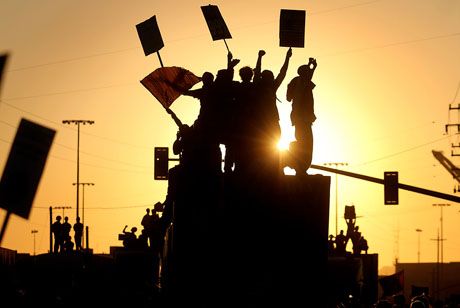News
You are here
Mobilizing can stop the Tories

November 23, 2011
Ontario Tory leader Tim Hudak threatened to channel the anger against the Liberals—who closed hospitals, raised tuition fees and cut social assistance—into a right-wing response that would continue similar policies.
After Rob Ford became Mayor of Toronto and Stephen Harper won his federal majority, media pundits and political party leaders assumed Ontario had lurched to the right, and that a “Tory hat-trick” would be inevitable. Hudak followed this perspective, starting his campaign denouncing “foreign workers” and ending by distributing homophobic leaflets. But this bigotry and his association with Rob Ford ruined his victory—because of mobilizations from below.
Since the spring there has been sustained mobilizing against Rob Ford. In April thousands rallied against the cuts. In June Ford’s boycott of Pride caused an outcry that isolated him. In July an explosive campaign to defend libraries put him on the defensive, while a marathon of deputations against the cuts revealed that “Ford Nation”—a Tea Party style army of citizens demanding austerity—was a myth. In September a poll found strong opposition to cuts in every ward, and on September 27 thousands of people rallied in defense of jobs and services.
This mobilizing in the streets shifted the terrain around the ballot box—quickly turning Ford into such a liability to Hudak that he was not allowed to openly endorse him.
NDP misses the orange wave
In May the federal NDP achieved historic resultsbased on years of anger at Tory austerity and Liberal complicity. The outpouring of support after Jack Layton’s death confirmed that the “orange wave” was based on people’s hopes of a fighting alternative.
But much of the NDP leadership federally and provincially drew the opposite conclusion, that their electoral victories are based on pushing the party to the centre.
Ontario NDP leader Andrea Horwath refused to challenge Hudak on his racism, declared a “buy Ontario” campaign based on hostility to Quebec, avoided environmental issues, and spent much of her time providing reassurances that she would balance the budget. The main message was that Horwath would freeze tuition fees and transit fares at the inaccessible levels to which the Liberals had raised them, and that she wore high heels.
As a result, the NDP missed the wave of resistance and only increased their vote by 5 per cent (from 17 to 23 per cent), which came from the Green Party (which dropped from 8 to 3 per cent). While the concentration of the progressive vote in the labour party is positive, there was no overall increase in this vote. Conversely there was no significant drop in the combined corporate vote, which went from 74 to 73 per cent—as a 3 per cent gain for the Tories (from 32 to 35 per cent) came from a 4 per cent loss to the Liberals (from 42 to 38 per cent).
Another reflection of untapped anger is the voter turnout: for the first time in Ontario’s history, a majority of eligible voters refused to vote, despite highly promoted changes to make it as easy as possible to vote. A declining voter turnout was seen in other elections across the country—from Manitoba to PEI—and is part of a global trend, as the system’s mechanism’s for reform fail to deliver. This is not a sign of apathy but of anger with the system, coinciding with the electric response to the Occupy Wall Street movement—a renewal of the anti-capitalist movement.
McGuinty’s “major minority” was based on only 1.58 million votes, out of 8.7 million eligible voters in a province of 13 million people. He and the Tories have no mandate for austerity, and there are seven more NDP MPPs who have the potential to provide an opposition—if they unite with the growing movements outside social democracy fighting for a real alternative.
Section:
- Log in to post comments










